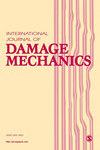Damage behavior of functionally graded kevlar/carbon epoxy nanocomposites reinforced with polyamide 6.6 nanofiber and MWCNTs subjected to low-velocity impact
IF 3.9
2区 工程技术
Q2 MATERIALS SCIENCE, MULTIDISCIPLINARY
引用次数: 0
Abstract
The use of carbon and kevlar fiber-reinforced composite materials continues to grow in high-tech applications such as aerospace engineering. One of the most desired properties in composite structures is a strong interfacial bond between the matrix and the fiber. Nano-material reinforcement is one of the most preferred methods for strengthening the fiber-matrix interfacial bond. In the present research, polyamide 6.6 (PA 6.6) nanofiber and multi-walled carbon nanotubes (MWCNTs) reinforced kevlar fabric (KF), carbon fabric (CF) and epoxy matrix nanocomposite plates were produced by functional grading of these two fabrics. PA 6.6 nanofibers, obtained by electrospinning, were placed between the layers, and 12-layer nanocomposite plates were fabricated using a vacuum-assisted hand lay-up method. In producing MWCNTs reinforced nanocomposite plates, 0.3 wt.% of MWCNTs were added into the epoxy matrix. A comprehensive set of 16 distinct composite plates was manufactured, encompassing unreinforced plates, plates reinforced with MWCNTs, plates reinforced with PA 6.6, and plates reinforced with a combination of PA 6.6 and MWCNTs (PA 6.6-MWCNTs). The impact strengths of the produced composite plates were investigated at energy levels of 20, 40 and 60 J. The effects of reinforcing the composite structure with MWCNTs, PA 6.6, and PA 6.6-MWCNTs, as well as functionally grading KF/CF on impact strength, were investigated in detail. The damages that occurred in the material as a result of the low-velocity impact tests were interpreted by examining the high-resolution camera and optical microscope images. Thus, the nanofiber and nanoparticle reinforcement to composite structure and hybridization effect were evaluated together. With the reinforcement of PA 6.6, MWCNTs and PA 6.6-MWCNTs, the impact strength of the nanocomposite samples increased significantly compared to the unreinforced samples. Moreover, the amount of damage caused by the low-velocity impact test in reinforced samples was significantly reduced.聚酰胺6.6纳米纤维和MWCNTs增强功能梯度凯夫拉/碳环氧纳米复合材料在低速冲击下的损伤行为
碳和凯夫拉纤维增强复合材料在航空航天工程等高科技应用中的应用继续增长。复合材料结构中最理想的特性之一是在基体和纤维之间有很强的界面结合。纳米材料增强是增强纤维-基体界面结合的首选方法之一。本研究通过对聚酰胺6.6 (pa6.6)纳米纤维和多壁碳纳米管(MWCNTs)增强凯夫拉织物(KF)、碳织物(CF)和环氧基纳米复合材料板的功能分级,制备了聚酰胺6.6 (pa6.6)纳米纤维和多壁碳纳米管增强凯夫拉织物(KF)。将静电纺丝获得的pa6.6纳米纤维置于层与层之间,采用真空辅助手铺法制备了12层纳米复合材料板。在制备MWCNTs增强纳米复合材料板时,在环氧基体中加入0.3 wt.%的MWCNTs。制作了一套完整的16种不同的复合材料板,包括未增强板、MWCNTs增强板、pa6.6增强板和pa6.6和MWCNTs组合增强板(pa6.6 -MWCNTs)。研究了制备的复合材料在20、40和60 j能级下的冲击强度,并详细研究了MWCNTs、pa6.6和pa6.6 -MWCNTs对复合材料结构的增强作用,以及KF/CF的功能分级对冲击强度的影响。通过检查高分辨率相机和光学显微镜图像,解释了由于低速冲击试验而在材料中发生的损伤。因此,纳米纤维和纳米颗粒对复合材料结构的增强作用和杂化效应被共同评价。添加PA 6.6、MWCNTs和PA 6.6-MWCNTs后,纳米复合材料的冲击强度明显高于未增强的样品。此外,低速冲击试验对增强试样造成的损伤量也显著降低。
本文章由计算机程序翻译,如有差异,请以英文原文为准。
求助全文
约1分钟内获得全文
求助全文
来源期刊

International Journal of Damage Mechanics
工程技术-材料科学:综合
CiteScore
8.70
自引率
26.20%
发文量
48
审稿时长
5.4 months
期刊介绍:
Featuring original, peer-reviewed papers by leading specialists from around the world, the International Journal of Damage Mechanics covers new developments in the science and engineering of fracture and damage mechanics.
Devoted to the prompt publication of original papers reporting the results of experimental or theoretical work on any aspect of research in the mechanics of fracture and damage assessment, the journal provides an effective mechanism to disseminate information not only within the research community but also between the reseach laboratory and industrial design department.
The journal also promotes and contributes to development of the concept of damage mechanics. This journal is a member of the Committee on Publication Ethics (COPE).
 求助内容:
求助内容: 应助结果提醒方式:
应助结果提醒方式:


